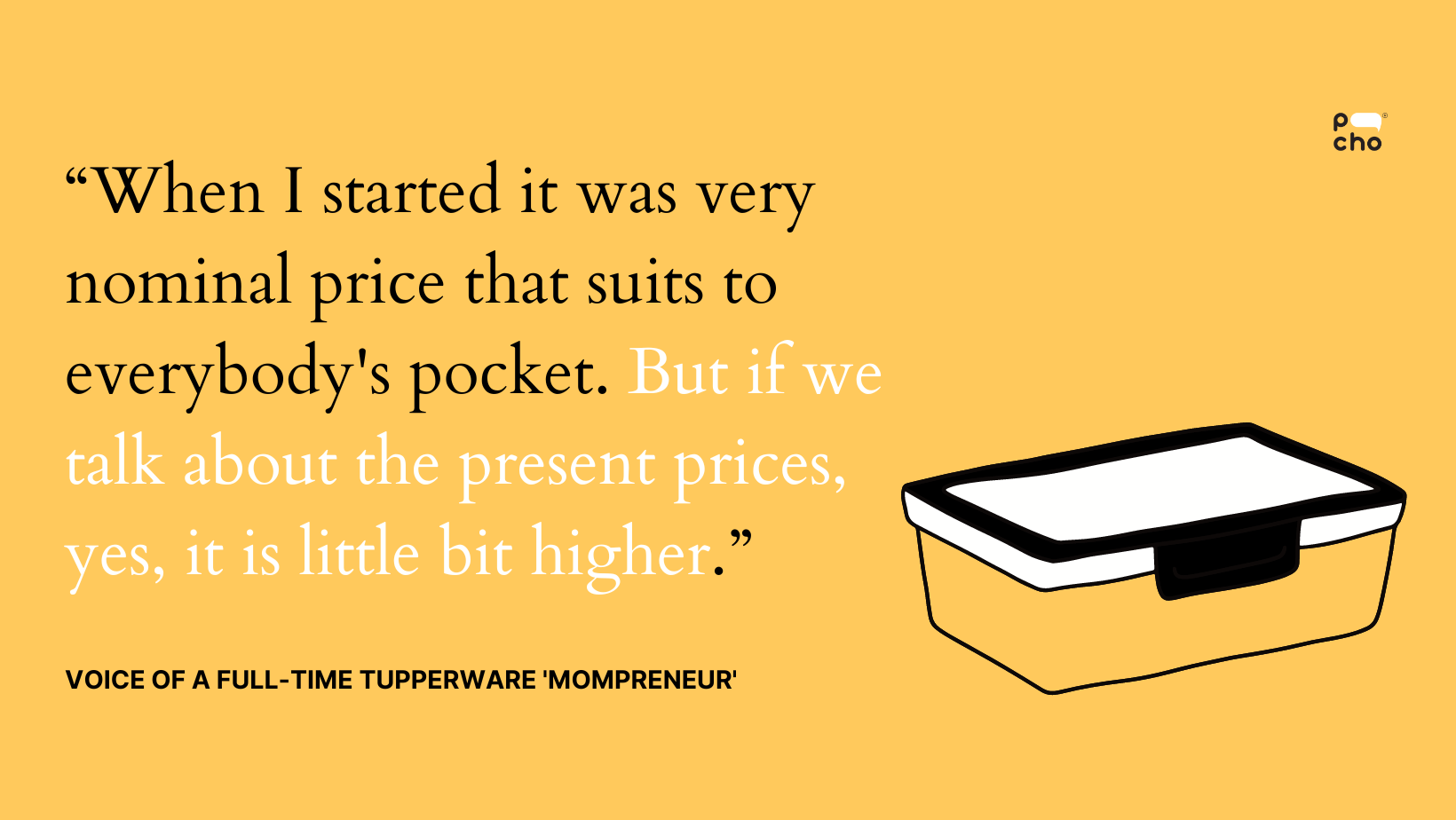💬Is Tupperware losing its shine?
Anita, a full time direct-seller of Tupperware products, reflects on her seventeen-year long experience with the company.

Written by: Tarushi Mohan
Currently based out of Noida, Anita Mishra* worked with Amway, Oriflame and Avon before finding her true calling in Tupperware seventeen years ago. Once her sons went off to college, she started spending most of her time as a Tupperware direct seller and is now an integral part of the network.
“My sons are in hostels now. So I'm free so I can devote more time but earlier when my kids were in the school, we used to do that first half, say till 2 o'clock, we used to choose those 2 - 4 hours for our work”, Anita mentions. Now a full time direct-seller and an ardent believer in Tupperware, as a product and employer, she spends a lot of time expanding her network.
Being a direct-selling entrepreneur provides Anita with the flexibility to work in her own time. “It is a business of ease, like more you work more you earn that way”, she explains. Initially apprehensive of working in the second half, she now has the liberty to hold meetings and “parties” at any time of the day.
“Tupperware is based on a party system. It was started like this only, that there is a connection with any lady who is known to us. We offer her, “just you call your friends, family members, anybody,” and the number should be 8 to 10. And we used to take our display over there like current products or maybe our effective products. We go there, we prepare a recipe while using those products and explain the utility of those products,” says Anita.
Even today, Anita has a party planned for the evening and she is busy planning interesting recipes along with interactive games to keep her audience engaged.
Being the flagbearer of empowerment for “mompreneurs”
There was a time when Tupperware was the staple in every Indian mother’s kitchen. Losing a Tupperware tiffin box attracted more wrath than losing marks for most kids. Tupperware containers were almost a revolution in the field, providing better leakage prevention than the traditional aluminum or steel boxes with the bright colors and attractive designs being the cherry on top.
Owning Tupperware was a matter of pride but it was also much more than that. One of the first brands to introduce direct-selling in India, it provided home-makers a chance to earn their own money without having to compromise on their household responsibilities. Tupperware entered the Indian market in 1996 and led to the birth of multiple “mompreneurs” - housewives and moms who’d sell Tupperware from their own houses.
Reminiscing, Anita talks about how her journey with Tupperware began. “Truly speaking, I met a lady say 17 years back she used to do this type of thing and I've seen the products that time. What attracted me is the colors.” Starting out as a customer attending one of the parties, Anita gradually became a regular attendee and got absorbed in the network. She visited the Tupperware office and within 2 months was a manager. “What Tupperware company is providing you like if I found someone and that lady is interested in working because it's a networking so we are joining people. We are adding more and more people.”
Tupperware evolves with changing times
Launched in 1946, Tupperware has an 80 year legacy. Although introduced in India half a century later, this brand has had to keep up with changing times to stay on top of its game.
From inflation to recession and Covid lockdowns, Tupperware has seen it all. The rising cost of living not only impacted the buyers but also the direct-sellers, whose business model is primarily based on personal connections and word-of-mouth.
“It takes time for people to accept now that prices are rising and rising and it is happening in every sector, so obviously raw material is expensive and transport is expensive, the prices are increasing day by day. When I started it was very nominal price that suits to everybody's pocket. But if we talk about the present prices, yes, it is little bit higher,” Anita woes.
To justify its rising prices, Tupperware offers lifetime replacement for loose seals along with the assurance of using high-quality virgin plastic, but it has not been enough to convince the new generation, especially with the ongoing anti-plastic wave.
Will Tupperware reclaim its top spot or collapse?
Struggling with inflation and recession, Covid-19 had a huge impact on the company’s core model. “Earlier it was like we are free to go at anybody's place but then things changed during COVID so now people are not that welcoming. Okay, so like COVID has affected everybody and there is and should be fear of any new person coming to your place and sometimes it happens we are going in a three person team so that way, it was difficult to hold sessions,” says Anita.
Their entire business model is built on networking and direct-selling, with in-person selling being the most effective. With people apprehensive of holding parties and sessions, entrepreneurs like Anita have had to resort to different workarounds in a bid to match profits from the pre-lockdown times.
In addition to the physical limitations, the on-going anti-plastic wave also hit sales in a big wave. Environment-conscious Gen Z and Millennials are wary of plastic containers, especially given the affordability and availability of pocket-friendly and attractive glass containers.
“People are not buying Tupperware for microwaves, otherwise we used to have a very different complete range for microwaves. Only now that sales have gone down because that is the phenomena or this approach of people that don’t use plastic in microwaves and all,” says Anita. Even though Tupperware advertises its use of virgin plastic which is not harmful to the environment, it has not appealed to the new generation as much.
There is also a shift in the general utility approach - from mothers looking for containers that would last years, even if priced a little higher to the new generation that is more likely to go for the new best thing, discarding the older models. “They say rather than spending 500 rupees in one box, let us spend 500 rupees for two boxes, we will use it for one year and we'll throw it away. What policy we are working on is that after you have any issue with that box you can replace it but now that mental state has been changed to like, ‘Okay, we can change the kitchen or we can throw the product that way,’” Anita mentions.
With Tupperware recently announcing that it could collapse without emergency funding, the company’s stocks plummeted almost 50%. Tupperware has itself expressed substantial doubt about its ability to continue. So the question is, What will it take for Tupperware to rise back to reclaim its top spot in Indian kitchens?
*We anonymize participant names to protect their identities and encourage more honest dialogue.



